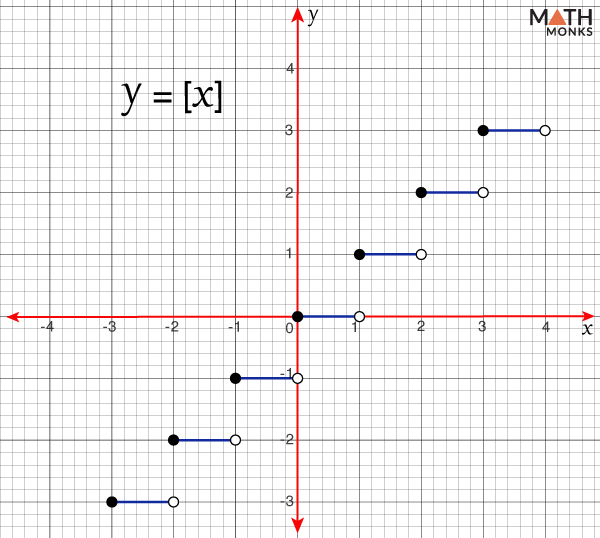
The greatest integer function is a type of mathematical function that results in the integer being less than or equal to a given number. It is also known as the step function.
It is denoted by the symbol f(x) = ⌊x⌋, for any real function, which is:
⌊x⌋ = n, here ‘n’ is an integer and n ≤ x < n + 1
For example, ⌊2.02⌋ = 2, as 2 ≤ 2.02 < 3
Thus, the function rounds off the real number to the integer less than the number.
There are 2 rules when finding the greatest integer values:
If the number inside the brackets is an integer, we return to the original number. For example, if f(x) = [44], the greatest integer value is 44
Suppose the number inside the brackets is not an integer. In that case, we return to the smaller integer close to the given number. For example, if we have f(x) = [-14.2], the 2 closest integers are -14 and -15. However, for the greatest integer value, we choose the smaller integer. Thus, [-14.2] = -15
This result is shown using a number line:

Since the largest integer less than -14.2 is -15, so [-14.2] = -15
The domain of the greatest integer function is a group of real numbers divided into intervals like [-4, 3), [-3, 2), [-2, 1), and [-1, 0). The corresponding ranges are the integers obtained from the function.
| Domain (x) | Range y = f(x) |
|---|---|
| 1.15 | ⌊1.15⌋ = 1 |
| 2.3 | ⌊2.3⌋ = 2 |
| 7 | [7] = 7 |
| -3.010 | ⌊-3.010⌋ = -4 |
The common properties are:
When graphing the greatest integer function, we first prepare a table of values corresponding to the domain and range of the given functions and then plot the values in the XY-coordinate. Such a graph is called the step curve as the graph is steep, and the function plotted is called the step function.
Considering f(x) = x, if x is an integer, the value of f is x. However, if x is a non-integer, then its value will be the integer immediately left to x on the number line.
For example, for numbers within the interval [0, 1), the value of f is 0. For the interval [1, 2), the value is 1, and so forth.
So for any integer n, all the numbers within the interval [n, n+1) will have the value n for the greatest integer function. Thus, the greatest integer function of the interval [4,5) will be 4.
For the function f(x) = x, we will create a table of values for the intervals -3 to 3.
| Domain (x) | Range f(x) | Closed dot | Open dot |
|---|---|---|---|
| [-3,-2) | -3 | (-3, -3) | (-2, -3) |
| [-2, -1) | -2 | (-2, -2) | (-1, -2) |
| [-1, 0) | -1 | (-1, -1) | (0, -1) |
| [0, 1) | 0 | (0, 0) | (1, 0) |
| [1, 2) | 1 | (1, 1) | (2, 1) |
| [2, 3) | 2 | (2, 2) | (3, 2) |
| [3, 4) | 3 | (3, 3) | (4, 3) |
Each interval will have a shaded point on the smaller integer and an unfilled dot on the bigger one, with vertical lines connecting the dots. The exact process is followed for each interval.
After plotting, the graph looks like as shown below:

The function plotted in the graph is called the step function.
Find the greatest integer function for the following:
(a) ⌊-255⌋
(b) ⌊2.501⌋
(c) ⌊-1.898⌋
Find the value of x in ⌊x+1⌋ = 4
As we know, 4 ≤ x+1 < 5
Subtracting 1 from the inequality, we have
3 ≤ x < 4
Thus, x has a range from greater than equal to 3 and less than 4
Substituting the value of -4.4 in the given expression, we get
f(-4.4) = [2(-4.4) + 1] = [-13.2 + 1] = [-12.2]
So, the value of f(-4.4) is -13
Last modified on August 3rd, 2023